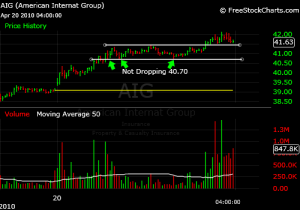A very talented experienced trader joined our desk about five months ago. Let’s call him Trader Dan. He decided SMB was a better fit for his personality than his original trading firm. His first trading job entailed shorting very strong stocks intraday and getting long very weak stocks intraday. Somehow he was able to earn a living with that strategy for many years but it was slowly eating away at his sanity.
He has done a nice job of learning what we teach and putting his stamp on his own brand new trading style. Despite his many strengths he has one area in particular with which he has struggled. Based on the many emails we receive I know that he is not alone. He has been unable to figure out a way to get back into a trade once he closes his initial position.
Let’s discuss the stock he was trading today. He was long 2K AIG from 40.60. He thought there was potential for AIG to trade at least up to 42. There was definitely evidence on the tape to support the idea that AIG would eventually make a nice move above 41. In fact, midday I was giving a lecture to our most recent trainees and one of them had a question about AIG. He observed that “it seems like recently AIG has spiked above 41 intraday but it always fails. How do you know if today is the day it will follow through?” My response was that based on the volume spikes both before and after 11:00am there was strong evidence that AIG could close higher today but it would need one more spike in volume to pull it off.
Back to Trader Dan. After AIG failed to hold above 41 for the second time Trader D hit out of his 2K shares. I think he made around forty cents on the trade but never got back in for the move that pushed AIG up to 42.
How To Get Back In
Tip #1: Don’t hit out your entire position if it is a trade that is working for you. Now this isn’t technically giving you a way to get back in but the truth is that most times you should have never been flat in the first place. If a trade is not working then it makes perfect sense to me to get flat the whole thing. But if a trade is working for you then scaling out is appropriate 95% of the time. Almost never will you be able to pick tops and reversals. Scaling out of a position ensures that you will still be involved for the entire move on most occasions.
Tip #2: If you get flat a position and the price you sold begins to act as support bid to get the stock back. In other words you sold the stock because you believed it was going to trade lower but its NOT TRADING LOWER. So buy it back as close to the price you just exited and keep your stop tight.
Tip #3: Generally, a position that trades in your favor has large institutional orders pushing the stock in the direction that you are risking your capital. The large buyers/sellers quite often will continue to accumulate/distribute at similar prices thereby giving you a perfect opportunity to re-enter your position when it touches one of those prices again. Check out the chart below. Three times AIG pulled back close to 40.70 and each time did not drop the 40.70 bid. Third time was the charm as it led to the final up move to 42.
Tip #4: Set an alert for the trend high or low from the first half of the day. When a stock breaches this price later in the day there is a good chance for follow through. ESPECIALLY if there were large volume spikes earlier in the day in the direction of the stock’s intraday trend.
Tip #5: If a stock consolidates in a tight range very close to a previous support/resistance level when it breaches that key level it is more likely that there will be follow through so should be used as a place to re-enter a position.
Hopefully these tips will give you an idea of how you can develop detailed plans on how best to take advantage of the opportunities you have identified each day. It only takes one good stock per day to be a consistently profitable trader. Just ask all the future traders who focus on a single contract each and every day 🙂



4 Comments on “How To Get Back In”
Love the tip addition to SMB Blog. Awesome post!
Love the tip addition to SMB Blog. Awesome post!
Can the Bid-Ask spread also give one a clue on which direction AIG would have traded?
Can the Bid-Ask spread also give one a clue on which direction AIG would have traded?